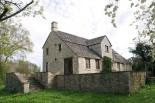 I achieved a long-cherished ambition today. I finally managed to visit the rose gardens at Mottisfont Abbey, in Hampshire - arguably one of the finest in Britain. I went with Zoe, who lives locally and knows the gardens really well. She also loves roses, so it was a bit like having a private guided tour from an expert.
I achieved a long-cherished ambition today. I finally managed to visit the rose gardens at Mottisfont Abbey, in Hampshire - arguably one of the finest in Britain. I went with Zoe, who lives locally and knows the gardens really well. She also loves roses, so it was a bit like having a private guided tour from an expert.As the name suggests, Mottisfont was originally a monastery, founded at the beginning of the 13th century. Like so many religious communities, it was confiscated during the Dissolution of the Monasteries ordered by Henry VIII, and given to one of his favourites. The "font" refers to the fountain, or spring, which gushes from deep in the ground.

A short stroll from the house leads up past the stable block to the rose gardens, where the historic collection of old shrub roses amassed by Graham Stuart Thomas is held. As advisor to the National Trust for 30 years, Stuart Thomas was responsible for restoring some of the most beautiful gardens in Britain. You can read more about his work at Mottisfont here.
The rose gardens are in what used to be the old walled kitchen garden. The first is divided into four squares, with a lawn in the middle of each square. The old walls help contain the fragrance of the roses.
A short stroll from the house leads up past the stable block to the rose gardens, where the historic collection of old shrub roses amassed by Graham Stuart Thomas is held. As advisor to the National Trust for 30 years, Stuart Thomas was responsible for restoring some of the most beautiful gardens in Britain. You can read more about his work at Mottisfont here.
When I was little, rose gardens meant rows of hybrid teas in bare soil, pruned within an inch of their lives, so that for most of the year they looked like a bizarre collection of sticks. I think this is what has given hybrid teas such a bad name. Many of them are gorgeous roses, which smell fantastic. I think it's true, though, that they are rather ungainly plants compared to the old shrub roses, that can arch and swoop through a border.
At Mottisfont, although the predominant plants are roses, the borders are also planted up with campanula, hardy geraniums, phlomis, achillea and even the extraordinary giant scabious, Cephalaris gigantea.
Apple trees support not only climbing roses but also clematis, while sprouting the odd bunch of mistletoe just for good measure.
 The planting is cleverly balanced so that the roses, although they have a starring role, do not completely overshadow the herbaceous perennials. You're still aware of contrasts in colour and texture and shape. The result is very harmonious, which makes the garden a lovely place just to be.
The planting is cleverly balanced so that the roses, although they have a starring role, do not completely overshadow the herbaceous perennials. You're still aware of contrasts in colour and texture and shape. The result is very harmonious, which makes the garden a lovely place just to be.
 This is the classic view of Mottisfont, the rose walk - planted with the climber Adelaide d'Orleans. It's a very pale pink, with darker buds.
This is the classic view of Mottisfont, the rose walk - planted with the climber Adelaide d'Orleans. It's a very pale pink, with darker buds. There are two rose gardens at Mottisfont - the historic old roses garden and the new rose garden, below.
There are two rose gardens at Mottisfont - the historic old roses garden and the new rose garden, below. The climbing rose on the pergola is 'Debutante', a Wichurana rambler (below)
The climbing rose on the pergola is 'Debutante', a Wichurana rambler (below)

 I love the eremurus erupting from this border like a flowery firework.
I love the eremurus erupting from this border like a flowery firework.
 Even the propagation area is as pretty as a picture
Even the propagation area is as pretty as a picture
















